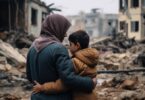Around the world, children as young as 5 years old are working in mines, fields, and factories. They’re exposed to brutal working conditions like long hours, toxic materials, sexual exploitation, pollution, and dangerous equipment. While child labor has decreased over the decades, there are still millions of kids facing exploitation. In this article, we’ll define child labor, provide eight examples of the most common forms, and explain where you can find more learning opportunities about child labor.
Child labor disrupts a child’s education, damages their health, and exposes them to violence, sexual abuse, and exploitation. The most common types include debt bondage, sex trafficking, armed conflict, forced criminal activities, agriculture, mining, factory work, and domestic work.
What’s the meaning of child labor?
The International Labour Organization (ILO) defines “child labor” as work that takes a young person’s childhood away from them. The work is “mentally, physically, socially, or morally dangerous and harmful” to kids and interferes with their education. As an example, putting a 15-year-old to work in a salt mine for 12 hours a day is child labor, while hiring a 15-year-old to wash dishes after school is most likely not. Laws vary from country to country. The United States has regulations regarding what hours 14 and 15-year-olds can work, while certain occupations (like power-driven bakery machines and power-driven forklifts) are completely prohibited for all minors.
The Convention on the Rights of the Child (CRC), which was adopted in 1989, states that all ratifying parties must recognize a child’s right to be protected from economic exploitation and performing hazardous work. It also requires State Parties to take legislative, administrative, social, and educational measures to enforce this right. The CRC is the most widely ratified human rights treaty, although the United States and Somalia have not ratified it. In 2020, the ILO announced that all ILO party countries had ratified Convention No. 182 on the Worst Forms of Child Labor, which provides for the elimination and prohibition of child labor like slavery, trafficking, armed conflict, pornography, and illegal activities. Convention No. 182, which was adopted in 1999, is the fastest ratified agreement in UN history.
How long has child labor existed?
Child labor has a long history, and for centuries, it wasn’t considered exploitative. From a very young age, children were expected to contribute to their families and communities. Why? The concept of childhood wasn’t as accepted as it is today. As the philosophy around children and childhood changed, so did society’s view of child labor. Child labor laws were passed and rates of child labor fell around the world. It’s still prevalent in areas affected by poverty. In 2016, global estimates found that ⅕ of kids in Africa are involved in child labor.
What are examples of child labor?
Child labor refers to any exploitative and harmful labor performed by a child. Here are eight examples:
#1. Debt bondage
When people go into debt and can’t pay with money or goods, the person owed the money may suggest that family members – including children – work for very little or for nothing to pay off the debt. This is often a trick as the debt-holder has no intention of lifting the debt or ending the forced labor. Because the debt can never be paid, debt bondage can keep multiple generations enslaved. This form of exploitation was one of the most prevalent types of forced labor in 2016.
#2. Child sex trafficking
Child sex trafficking is the buying, selling, and moving of children for sexual exploitation. Precise numbers are hard to calculate, but a 2016 UNODC Global Report found that women and girls are trafficked more often for sexual slavery and marriage. Armed groups are a common perpetrator, although experts say trafficked children are very likely to know or even be related to their exploiters.
#3. Armed conflict
According to UNICEF, more than 105,000 children were exploited in armed conflict between 2005 and 2022. Because of how difficult it is to track child labor statistics, the number is likely higher. Children in armed conflict are used as soldiers, scouts, cooks, guards, messengers, and more. Some are abducted or threatened into work, while others are trying to earn money for their families. Regardless of the specifics, using children for any reason in armed conflict is a major violation of human rights law.
#4. Forced criminal activities
Children are exploited for a variety of criminal activities, such as theft, producing and trafficking drugs, burglarizing homes, and more. According to a post on The Conversation, organized crime gangs can groom and exploit kids as young as 12 years old. Kids may be initially paid with drugs and alcohol, which can trigger addiction and make it even harder to break free. In Ecuador, police found stuffed animals at one cartel hideout, leading them to believe that the gang was using toys to lure children. In that same area, most of the 230 people arrested between January and April 2022 were just 17 or 18 years old.
#5. Agriculture
According to the International Labour Organization, child labor is concentrated in agriculture. 60% of the child laborers aged 5-17 years old are in work like farming, fishing, livestock, forestry, and aquaculture. Poverty is the main driver of child labor in agriculture. Child labor may also be more widely accepted in agriculture because of its long-standing history. Children can participate in agricultural activities on family farms without being child laborers, but any work that interferes with schooling, harms a child’s health and development, or exceeds what’s age appropriate for the child is exploitation.
#6. Mining
Mining is a dangerous activity even for adults, but around the world, thousands of kids labor in mines for materials like cobalt, salt, gold, and mica. In the Democratic Republic of the Congo, children as young as seven mine for cobalt, which is used for lithium-ion batteries. In 2014, around 40,000 kids were working in cobalt mines. Conditions can be brutal and deadly. Many miners work long hours without protective equipment for pay as low as 1-2 dollars a day.
#7. Factory work
Factories make a huge amount of products like clothing, toys, and meat. They’re also rife with poor ventilation, toxic materials, and hazardous machinery. When kids are exploited in factories, they face long-term health and development consequences. In 2023, the United States Department of Labor discovered more than 100 kids – some just 3 years old – employed in factories across eight states. Their jobs included cleaning dangerous equipment like bone cutters and skull splitters in meatpacking plants.
#8. Domestic work
Domestic work includes a variety of tasks and services, some of which don’t constitute exploitative child labor. Exploitation occurs when kids are employed in the domestic work sector at ages younger than is legal and are exposed to hazardous conditions. Any domestic work that interferes with a child’s education is also child labor. In many places, domestic work exploitation is “hidden” as kids – especially girls – are expected to contribute to the household and prepare for a life as an adult. According to the International Labour Organization, kids face heightened risks when they live in the household where they’re employed. Without consistent contact from the child’s parents or friends, it’s much easier for employers to exploit a child.
Where can you learn more about child labor?
Child labor is one of the most troubling human rights violations. Here’s a short list f of classes, books, and documentaries that shine a light on this urgent issue:
The ILO’s e-learning tools
The International Labour Organization offers a handful of courses to help students understand child labor and what role ILO stakeholders play. Using interactive tests and exercises, these free courses are self-paced. Examples include the reporting on child labor for media course, which is 8 hours long and available in English, and the eliminating child labor course, which is a 2-hour course for labor inspectors and child labor monitors. It’s available in French, Spanish, Vietnamese, English, and Mongolian.
FAO e-learning academy
The Food and Agricultural Organization of the United Nations offers a 2.5-hour course on child labor in agriculture. It gives an overview of child labor in agriculture, foundational knowledge on what is and isn’t child labor, its causes and consequences, and more. It’s available in English, Spanish, French, Turkish, and Russian. It’s also available in Portuguese as a downloadable offline package.
Harvard University’s Child Protection: Children’s Rights Theory in Theory and Practice
This 16-week course teaches students about the causes and consequences of child protection failures. Topics include the strategies, international laws, standards, and resources that protect all children, as well as how students can apply strategies to their careers. It’s a self-paced course, but it takes 16 weeks with 2-5 hours of work per week. Students can audit the course for free or pay a fee for a certificate.
Agents of Reform: Child Labor and the Origins of the Welfare State (2021)
Elisabeth Anderson
This book explores the late 19th-century labor movement, groundbreaking child labor laws, and the regulatory welfare state. Through seven in-depth case studies from Germany, France, Belgium, Massachusetts, and Illinois, Anderson explores individual reformers and challenges existing explanations of welfare state development.
Blood and Earth: Modern Slavery, Ecocide, and the Secret to Saving the World (2016)
Kevin Bales
Expert Kevin Bales, who has traveled around the world documenting human trafficking, describes the link between slavery and environmental destruction. In addition to being a human rights violation, human trafficking is destroying the earth. Backed by seven years of research and travel, Bales reports from places where this link is most concentrated. While it doesn’t focus exclusively on child labor, child labor is a huge part of human trafficking.
“The Chocolate War” (2022)
Director: Miki Mistrati
The cocoa and chocolate industry is rife with child slavery. In 2001, eight large companies, the World Cocoa Foundation, and the Chocolate Manufacturers Association signed a pledge to end child labor and slavery in Ghana and the Ivory Coast, but the deadline has been postponed to 2025. Why won’t the industry change? “The Chocolate War” follows Terry Collingsworth, a human rights lawyer, for five years as he takes on the multi-billion-dollar chocolate industry. The film was nominated for a Cinema for Peace Award and Best Documentary at the Warsaw International Film Festival.












